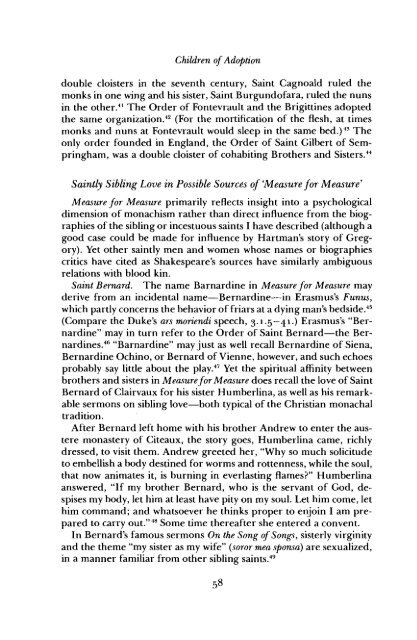Children of Adoption - People Fas Harvard
Children of Adoption - People Fas Harvard
Children of Adoption - People Fas Harvard
You also want an ePaper? Increase the reach of your titles
YUMPU automatically turns print PDFs into web optimized ePapers that Google loves.
<strong>Children</strong> <strong>of</strong> <strong>Adoption</strong><br />
double cloisters in the seventh century, Saint Cagnoald ruled the<br />
monks in one wing and his sister, Saint Burgund<strong>of</strong>ara, ruled the nuns<br />
in the ~ther.~' The Order <strong>of</strong> Fontevrault and the Brigittines adopted<br />
the same organizati~n.~~ (For the mortification <strong>of</strong> the flesh, at times<br />
monks and nuns at Fontevrault would sleep in the same bed.)45 The<br />
only order founded in England, the Order <strong>of</strong> Saint Gilbert <strong>of</strong> Sempringham,<br />
was a double cloister <strong>of</strong> cohabiting Brothers and sister^.^^<br />
Saintly Sibling Love in Possible Sources <strong>of</strong> 'Measure for Measure'<br />
Measure for Measure primarily reflects insight into a psychological<br />
dimension <strong>of</strong> monachism rather than direct influence from the biographies<br />
<strong>of</strong> the sibling or incestuous saints I have described (although a<br />
good case could be made for influence by Hartman's story <strong>of</strong> Gregory).<br />
Yet other saintly men and women whose names or biographies<br />
critics have cited as Shakespeare's sources have similarly ambiguous<br />
relations with blood kin.<br />
Saint Bernard. The name Barnardine in Measure for Measure may<br />
derive from an incidental name-Bernardine-in Erasmus's Funus,<br />
which partly concerns the behavior <strong>of</strong> friars at a dying man's bedside.45<br />
(Compare the Duke's ars moriendi speech, 3.1.5-41.) Erasmus's "Bernardine"<br />
may in turn refer to the Order <strong>of</strong> Saint Bernard-the Bernardine~.~~<br />
"Barnardine" may just as well recall Bernardine <strong>of</strong> Siena,<br />
Bernardine Ochino, or Bernard <strong>of</strong> Vienne, however, and such echoes<br />
probably say little about the play.47 Yet the spiritual affinity between<br />
brothers and sisters in Measure for Measure does recall the love <strong>of</strong> Saint<br />
Bernard <strong>of</strong> Clairvaux for his sister Humberlina, as well as his remarkable<br />
sermons on sibling love-both typical <strong>of</strong> the Christian monachal<br />
tradition.<br />
After Bernard left home with his brother Andrew to enter the austere<br />
monastery <strong>of</strong> Citeaux, the story goes, Humberlina came, richly<br />
dressed, to visit them. Andrew greeted her, "Why so much solicitude<br />
to embellish a body destined for worms and rottenness, while the soul,<br />
that now animates it, is burning in everlasting flames?" Humberlina<br />
answered, "If my brother Bernard, who is the servant <strong>of</strong> God, despises<br />
my body, let him at least have pity on my soul. Let him come, let<br />
him command; and whatsoever he thinks proper to enjoin I am prepared<br />
to carry OU~."~~ Some time thereafter she entered a convent.<br />
In Bernard's famous sermons On the Song $Songs, sisterly virginity<br />
and the theme "my sister as my wife" (soror mea sponsa) are sexualized,<br />
in a manner familiar from other sibling saints.49
















